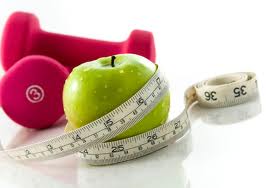Nutrition Article, Part 4
Apr 10th 2012
Progress, Not Perfection: Weight Loss Done Right, Nutrition Article 4 with Brandi Thompson, RD
It’s startling but true. Right now, 32 percent of men and 34 percent of women are obese. Brandi Thompson, Registered Dietician says the percentage of children that are obese is about the same, “As far as kids, 30% of the population are obese. That is up from the teen percentages in the Seventies."
With these types of numbers, it’s obvious that Americans need help. The population has been inundated with images of nutrition for decades: fruits and vegetables mostly and more recently whole grains and lean cuts of meat. I recall watching Saturday morning cartoons in the late Seventies and during commercials there were always PSA’s (public service announcements) for nutrition, in the form of cartoons of course.
Brandi relayed a story about a young woman she worked with. This was during Brandi’s early graduate work in nutrition. The young woman said that by eating a banana she was getting calcium, “It’s white," she explained to Thompson, “If it’s white, it has calcium." She had a misconception about what foods she was putting into her body and why.
A+B=C. Good nutrition plus exercise equals weight loss. It seems we all know this, but there is a disconnect. There are a couple of reasons to explain this disconnect. “Many people are confused by all the fad diets out there,” explains Thompson. “Fad diets may work in the short run,” says Thompson, “..but at the end of the day it’s about everything in moderation.” “One food, or one food group is not going to make you lose weight. You have to learn to balance your meals and portion size." Low carbohydrate diets such as “The Cabbage Soup Diet," etc. can help shed the pounds, but what happens afterwards? “Most often times..," explains Thompson, "..people gain the weight and then some."
People who are overweight or are obese usually figure it out themselves or are told by their doctor. Unfortunately, many folks skip going to the doctor because they don’t want to hear that they need to lose weight. For those who listen to doctor’s orders, however, a Registered Dietician can be a crucial part of your team.
 When asked how RD’s can help people lose weight, Brandi Thompson, R.D. said this: “We can look at behavior and daily intake and help the patient come up with goals and change the way they eat; we teach them about how foods affect them and provide meal plans that are written together." Thompson emphasized that meal plans should be a collaboration between an RD and patient. If, for example, a person does not like sweet potatoes and that is what has been written for him in his meal plan, his aptitude for following the meal plan goes down exponentially. “We can help guide people, educate them and listen to their eating habits for any psychological issues, in which case we can refer them to a mental health professional." The most common reasons people say that they are overweight include eating at restaurants too frequently and not having enough time to make food at home, hence eating processed food. An R.D. will help a person come up with easy-to-follow strategies for making a transition to make healthier choices and lose weight.
When asked how RD’s can help people lose weight, Brandi Thompson, R.D. said this: “We can look at behavior and daily intake and help the patient come up with goals and change the way they eat; we teach them about how foods affect them and provide meal plans that are written together." Thompson emphasized that meal plans should be a collaboration between an RD and patient. If, for example, a person does not like sweet potatoes and that is what has been written for him in his meal plan, his aptitude for following the meal plan goes down exponentially. “We can help guide people, educate them and listen to their eating habits for any psychological issues, in which case we can refer them to a mental health professional." The most common reasons people say that they are overweight include eating at restaurants too frequently and not having enough time to make food at home, hence eating processed food. An R.D. will help a person come up with easy-to-follow strategies for making a transition to make healthier choices and lose weight.
Of course diet alone cannot help shed the pounds. Adding exercise to one’s efforts plays a major role in losing weight. “The more active a person is, the more calories they burn, the better they feel." The level of activity (time, frequency, and intensity) will change as the person progresses in meeting her goals.
An excellent resource for those who are looking for healthly recipes, the science of weight loss, the benefits of weight loss, and more is the American Heart Association. In addition, the Academy of Nutrition and Dietetics is also helpful in creating meal plans, healthful eating and is a portal for finding a local Registered Dietician. Brandi Thomspon, R.D. also maintains a creative and educational website, www.abcdeatright.com, that can also be followed on Twitter: @abcdeatright1. 
Proper nutrition, a healthy psychology for food, and moderation are key to a peaceful relationship between a human and food consumption. It begins as infants and continues throughout our lives. How we eat impacts not only how our children eat but how our friends eat. With chronic illnesses such as high blood pressure, Type II diabetes, heart disease and high cholesterol on the rise, it behooves a nation to examine their plate, look at what is in their hand as it enters the mouth, and spend more time in the perimeter of the supermarket rather than the inside. Changing the way you eat to a nutritionally balanced and well portioned diet will allow you to enjoy life, enjoy food, and enjoy health for a lifetime.
Have you lost a considerable amount of weight? Ever tried a fad diet and kept the weight off? Do you have a child at home who is overweight? If so, how are you coping with that? How often does your family go out to eat? Have you made a switch from eating at restaurants to eating more at home? If so, why? What have the results been? Please share your stories for people to reflect upon and connect. You can provide a recap of your experience on the blog at the JumpSport Facebook page or on Twitter: @FitTrampoline.
Until next week, healthy living!
Heidi Aspen Lauckhardt-Rhoades
Writer and Social Media Correspondent
Professional Fitness Instructor
FB: The Write Fit & Open Barre Happy Hour
Twitter: @ATweetFit


